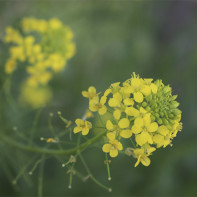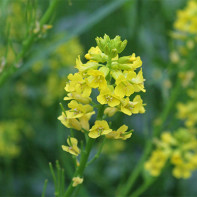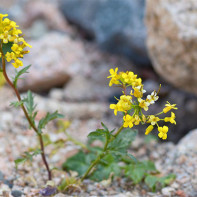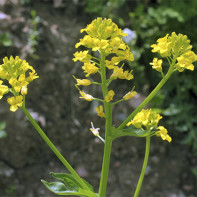Blunderbuss: useful properties and contraindications
Undoubtedly, everyone has seen grapes, just not everyone knows the correct name of this unattractive-looking plant. And few people have information about its useful qualities and healing abilities.
- Chemical composition
- How it looks and where it grows
- Types of
- Gathering and storage
- Therapeutic properties of the herb bittercress
- For Women
- For Men
- In pregnancy
- When breastfeeding
- For children
- Bitchwort in folk medicine
- For male infertility
- For prostatitis
- For erectile dysfunction
- For the treatment of sexual dysfunction in men
- Juice for men's health
- Culinary Applications
- Grapes salad
- Grapes salad with avocado
- Fritters with bittercress
- Herb rolls
- Asparagus pie
- Puree with herbs
- Fried fish with medley puree
- Herbal concoctions
- Infusion
- Infusion
- Tea
- Useful properties of oil of bittercress
- Can we give groundhail to rabbits?
- Contraindications to use
Chemical Composition
The chemical composition of bittercress gives the right to speak about it as a surprising and unique plant that combines a whole range of components - both useful and those that should be treated with caution.
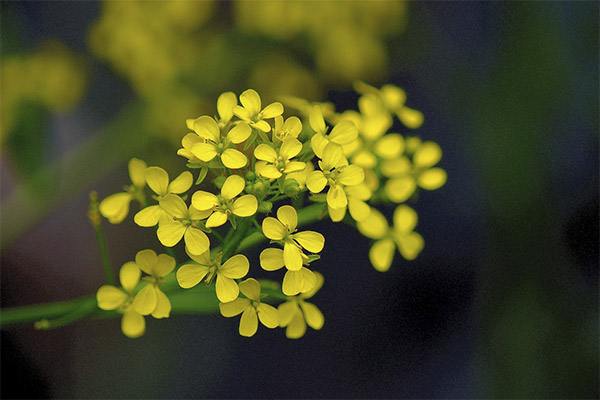
Among the useful ones are flavonoids known for their antioxidant properties, saponins and glycosides with a wide range of effects. At the same time, thioglycosides can provoke diarrhea. The leaves are valuable for their ascorbic acid content.
The seeds consist of more than a third of fatty oils, but they also contain toxic substances, as well as erucic acid, which can accumulate in the body with prolonged use.
Without organic acids and B vitamins, the picture of the chemical composition would be incomplete, these components of bittercress are necessary for the trouble-free work of the heart, nervous system and maintaining a normal emotional state of the person.
What it looks like and where it grows
In late spring on roadsides, fields, vegetable gardens, meadows, on the banks of rivers, lakes and ponds and in parks you can already find a plant studded with small yellow star-flowers, resembling a bush with a tall stem. It is found naked or with light down, with small leaves and covered with small yellow flowers. It is a weed that grows all over the world, from Europe to North America, from Africa to Australia and New Zealand. In Russia, it is everywhere - from the western European borders to Siberia.
Cuprepe is a representative of the cabbage (Cruciferous) family and belongs to the taproot perennials: that is, each plant from one season to another resumes its development on a single primary root grown from a seed. Over the years, the root grows farther and farther into the soil, and every spring a new young shoot appears on it again and again, capable of flowering and multiplying.
The leaves of bittercress are of two kinds. One goes straight from the root, on petioles, they are as if carved, with large lobes of oval-long shape on the sides and a large middle. The upper leaves have denticles on the edge, without petioles, sessile, they seem to hug the stem.
Inflorescence of bittercress is a bunch of bipolar flowers of pure sunny color. Their petals are just over 5 mm long and surround stamens with bright yellow pollen. After flowering, a pod begins to develop on the groundhog and grayish-brownish oval seeds with a finely tuberculate surface ripen in it.
The plant is so prolific that it can give birth to 10,000 seeds. The ripe seeds fly quite far from the mother plant - to 3 or more meters. The next year a new plant grows from them, not yet capable of reproduction: seeds on it will appear only in the second year, and after the end of the first year a strong, developed root will remain in the soil for the winter.
Germination requires a temperature of at least 6-8 degrees, and if the heat outside is above 38-40 degrees, the seeds are also unable to germinate. Seeds germinate quickly - they can do this in spring, fall, and summer.
Not only sunny, well-lit places are suitable for the growth of groundsel, it is quite able to exist comfortably and give birth in the penumbra as well. Depending on the location and growing conditions, the height of the plant can vary from 30 to 80 cm. It can grow in meadows or wooded glades as well as in thickets of bushes, in damp places around ponds, near rivers or other bodies of water, or near roads, ditches and piles of garbage.
As groundhog sprouts in early spring, the plants already put out seeds in early summer, which actively penetrate into fields. They thoroughly contaminate cultivated crops, especially on clay soils, which are not very well amenable to mechanized processing. And not all herbicides are able to overcome this weed.
Species
In nature, there are about 20 species of groundsel, but the most common of them only 4. These are wild, stone, arcuate and common.
- Common groundhog is tall - under 80 cm, with a smooth straight stem, blooms in May-June.
- The wild groundhog is similar in appearance to the common groundhog, differing only in the stem - branched and covered with hairs. It blooms for a long period starting in May and ending in November, with pods ripening by the end of summer. In addition to substances common to all types of rampel, wild ramp is rich in barium, magnesium, nickel and zinc.
- Arc-shaped gets its name because of the pods, which have a curved, arc-shaped shape. This is the most water-loving of all ramparts, which is why it is most often found around bodies of water. It blooms earlier than its cousins, in April or May.
- Stone groundhog differs from its relatives by its small stature, only 20-30 cm, and a little bit later flowering, which begins in June and lasts until October. It is this type of groundsel as the most decorative can be seen in flowerbeds: some flower growers use it as a background plant.
Harvesting and storage
In order to properly harvest grapes and get really good quality medicinal raw materials from them, you must remember: dry the plant so that it is not exposed to the sun's rays. The best places for drying would be a veranda, a pergola or an attic, where you can arrange a draught. Dried grapes should not be stored for more than a year. A paper bag or a plywood box will be perfect - the grass will breathe in them and won't lose its value over time.
Start stocking up in mid-May. At this time, groundsel is covered with flowers, they are cut together with stems and leaves, not forgetting the lower, coming from the root leaves. Then go through them to discard anything torn, insect-eaten or darkened, and send them to dry. Leaves and inflorescences are separated from the dried plants.
Roots are not harvested before the fall, because closer to the end of the season they accumulate the maximum amount of useful substances. Choose older plants with a large root, they are more useful. The dug up root is washed under running water, wiped with a paper towel and put to dry in the shade - so that it blows in a fresh breeze.
The time for harvesting seeds is in July, they are harvested while still green and then dried - but not in the sun, providing the inflow of fresh air so that the seeds won't get moldy. Store them directly in the pods, from where to get, when and as much as needed.
Therapeutic properties of the herb bittercress
Each part of the rampart is rich in one or another active substance in a different degree, this is the reason why for the treatment of some ailments are used, for example, the leaves, others - the root.
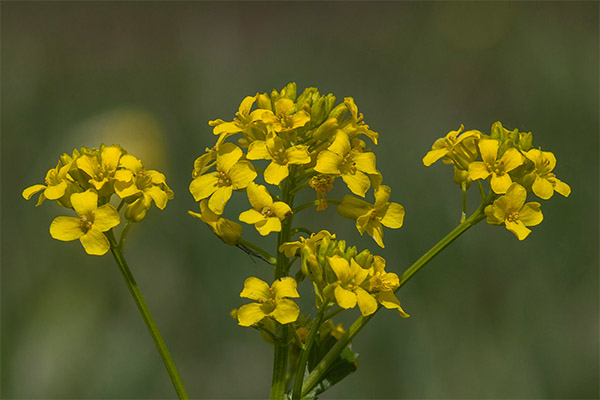
So, in the root, the main fiddle is played by flavonoids, their action - diuretic and mild laxative. The mechanism of action of these substances is as follows: they normalize blood vessels, as a result of which the lumen expands. As a result, more urine is produced. And the consequence is the reduction of edema and detoxification effect. In addition, remedies based on the root of bittercress have antifungal and antibacterial properties.
During photosynthesis, many vitamins are accumulated in the leaves, including ascorbic acid, organic acids and various trace elements. They are responsible for regulating acidity in the human body. Their "duty" is also to bring digestion in order, to increase the acidity of gastric juice, to normalize the amount of cholesterol and blood sugar.
Due to the vitamins, primarily ascorbic acid, the leaves are an excellent general tonic and immunostimulant. The plant can be used as a scurvy preventive, and salads with young leaves of bittercress in early spring enrich the body with vitamins.
The chemical composition of the inflorescences, as well as in other parts of the plant, a sufficient number of flavonoids, vitamins, trace elements, organic acids, glycosides. Flowers can be used as a diuretic and tonic. A characteristic feature of the inflorescences is that they have an increased concentration of B vitamins, which may be the basis for normalization of the nervous system.
The seeds are full of thioglycosides, which can increase appetite and improve digestion by stimulating the secretion of digestive juices thanks to their mild irritant action.
For women
In various female hormonal disorders and pathologies, bittercress has a positive effect. And this is proven in practice. If diagnosed with mastopathy, myoma or an inflammatory process, bittercress will be a good remedy in the complex treatment of the disease.
For men
In this way, you will be able to use it in the same way as you would use it in the same way that you would use it in the same way that you would use it in the same way that you would use it in the same way that you would use it in the same way that you would use it in the same way that you would use it in the same way that you would use it in the same way that you use it in the same way. Impotence, the need to improve the quality and quantity of seminal fluid, exacerbations of prostatitis - these are the cases when you need bittercress. In addition, this medicinal plant is able to improve the production of male sex hormones and eliminate hormonal imbalances.
Thanks to the strengthening of the walls of blood vessels and improve blood flow, which provides groundfoil, you can solve the problem of treating erectile dysfunction. It will help in this matter tea from the leaves of the plant, which combats the effects of stress, adverse environmental conditions, improper diet, having a negative impact on men's health.
The active ingredient quercetin, which is found in bittercress, acts as an antibiotic and fights the bacterial pathogens that disrupt the process of spermatogenesis.
However, you should not hope that you can cure male problems only with grapes. It is necessary to combine the intake of compositions based on bittercress with the treatment prescribed by the doctor. It is necessary to remember: a doctor's consultation is mandatory!
Pregnancy
Many pregnant women, seeking not to harm their future baby, try to avoid taking pharmacy drugs and replace them with natural analogues. So, for example, having learned about the property of bittercress to relieve swelling, they try to apply healing tinctures of this herb. But it is not necessary to do this. After all, as part of bittercress many different substances, and you can not predict in advance what action each of them will have on the not yet born baby. It is quite possible that the baby has an individual intolerance to any of the components of the herb.
Breastfeeding
Mothers who are breastfeeding should also not rush with taking teas, tinctures or decoctions of bittercress. Its active ingredients can get into the breast milk and cause an allergic reaction in the baby - a rash on the skin is quite possible. Diarrhea is not excluded because of the ability of bittercress to have a laxative effect.
For children
You should not rush to give toddlers under three years of age, because it contains substances that can cause allergies. With three years (or better - even with five) you can try to introduce greens in salads, give fish, stewed or fried with driftwood. It has a lot of vitamins, especially valuable leaves of garden turf in May.
Grapes in folk medicine
Despite the fact that grapeshot is considered a weed, you can not treat it disparagingly: it has many useful properties. First, it is an excellent honeybee, from which bees collect the first spring nectar. Honey harvested from bittercress contains an increased amount of glucose, it is yellowish-green in color, with a pleasant, but faint aroma. Due to its useful substances, the plant is in demand in folk medicine. Remedies, made on the basis of recipes from ancient books of herbalists, are good preventive agents against the development of age-related diseases, have a cleansing effect on the body and a good therapeutic effect in various male ailments.
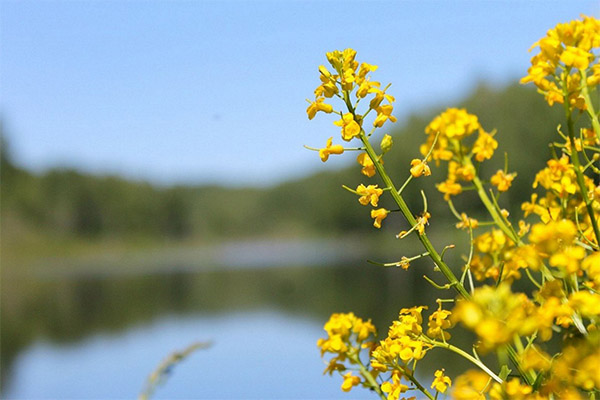
From male infertility
In infertility, which was caused by insufficient motility and mutation of sperm, the following remedy is effective. In a bottle of vodka, pour three tablespoons of dried ground bittercress. Insist two weeks, shaking from time to time. Then strain and use on an empty stomach three times a day - at least half, but no more than a tablespoon at a time.
With prostatitis
Just plucked leaves and stems of bittercress break in a blender or grind in a meat grinder. Squeeze the juice from the resulting pulp. Drink it for two months - every day before meals 4 times half a tablespoon.
With erectile dysfunction.
Take in equal proportions of dried leaves of such herbs: nettle, plantain, St. John's wort, sage, bittercane, mix and crush them, measure 10 grams, pour 200 ml of boiling water, cover with something warm and wait until it cools. Three weeks to drink in the morning and evening before eating.
For the treatment of sexual dysfunction in men.
Grind the dried root of the plant to a powdery state. Twice a week, take it 0.5 grams with water. Positive results will be noticeable after three weeks.
Juice for male health
To improve the quality of the male seed, the juice of bittercress is suitable. To get it, you need to twist in a mincer any above-ground parts of the plant, and then squeeze the juice through gauze. For at least two months, three times a day after a meal to drink 50 ml of juice.
Cooking applications
St. John's witch hazel is a fairly frequent guest on the dinner table, especially often used for cooking by the inhabitants of America and Canada. This plant is a wonderful addition to many dishes, adding them a little spice, very similar to the light mustard flavor with a hint of nutty flavor. Young leaves or unblossomed flowers are good for culinary purposes. The Japanese use the inflorescences as a garnish. The simplest dishes are salads.
To avoid bitterness, the leaves of bittercress should be boiled before cooking salads, but not longer than three minutes, as they become tasteless in longer contact with boiling water. After this procedure, no bitterness is felt at all, only a slight nutty flavor remains.
St. John's wort salad
Take a handful of chopped leaves and green onions, add two chopped chicken eggs to this mass, salt, mix and dress with mayonnaise or sour cream.
Saltbush salad with avocado
Dice one avocado, add cubed chicken egg, chop 30 gr of onion and 100 gr of rennet leaves. Season with salt and spices, add ground black pepper and nutmeg.
Pancakes with bittercress
Finely chop about 100g of washed and dried flowers of bittercress and a small onion. Grate one medium-sized potato onto a fine grater. Mix the potato mush with the onion and bittercress. Add one chicken egg, two tablespoons of flour, salt to taste and pepper. Mix well. The resulting dough with a spoon on a red-hot frying pan and fry on both sides. Serve best with sour cream.
Herb rolls
Wash young and tender zucchini and cut lengthwise into thin slices. Salt and put in the refrigerator for two to three hours, after this procedure, it becomes more elastic. Pureed leaves of grapeseed (about 60 g) and two peeled garlic cloves chop in a blender. Add garlic and grapes mixture to 150 grams of cottage cheese, put there a handful of chopped walnuts, thyme and cumin. Mix the mixture well. If it is too dry, add some milk, about a tablespoon, and mix again. Spread on zucchini plates, make rolls and put in the fridge for a couple of hours.
Tart with chives.
In a bowl, beat three eggs, pour 250 ml of kefir, add a teaspoon each of salt and baking soda. Then with constant stirring gradually add 350 grams of flour and a teaspoon of baking soda. The resulting mass is mixed thoroughly so that the dough is homogeneous.
Take 300g of mushrooms (you can bring them from the forest, you can buy mushrooms), soak them to remove all the dirt, rinse, cut into small slices. Boil 200g of rice.
Line a cake pan with baking paper, put mushrooms in a single layer on it. Put 300g of grated cheese on top of mushrooms as a second layer. The fourth layer is onions: peel and finely chop a medium-sized onion. For the fifth layer, chop 300g of washed dried rapeseed florets.
Carefully pour the batter on top and distribute it evenly over the entire surface. Put the form in the oven, preheated to 180 degrees. Approximate baking time - 45 minutes.
Mashed potatoes with bittercake
Chop a medium-sized onion, grate a small carrot on a fine grater, add 200 g of chopped leaves. Put everything into a pan and stew with sunflower oil until the vegetables are puréed. The side dish is ready!
Fried fish with puréed ramekins
400 g of washed cod fillets dry with paper towel, salt, sprinkle with ground ginger and black pepper. Coat each piece on all sides with mashed potatoes made of rampson. Then roll the fish in flour and fry in vegetable oil with the lid open. For 5 minutes before cooking, put in the pan chopped half rings onions and cover with a lid.
Types of medicinal compositions.
For the preparation of medicinal infusions and decoctions from bittercress any part of the plant is suitable, you only need to pre-wash the greens. It is important to remember: do not abuse the reception of life-giving compositions, before prescribing treatment yourself, it is better to consult a doctor.
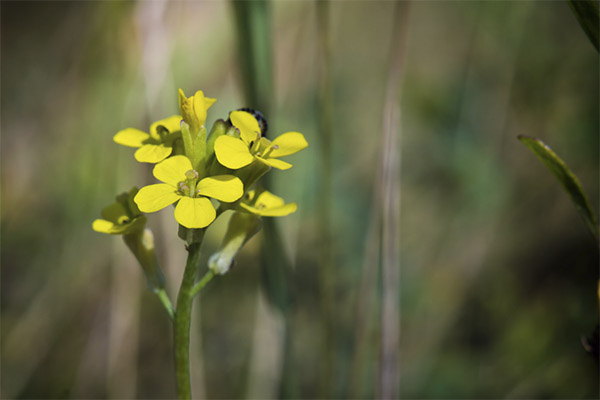
Infusion
Infusion for men. You can use groundhogs to relieve the symptoms of prostatitis. For a therapeutic infusion will require a tablespoon of dry crushed leaves, they should be poured with steep boiling water (250 ml). Then cover tightly and insist about 2-3 hours. Drink from one and a half to two tablespoons 3-4 times a day for half an hour before a meal. Full course - about two months.
Tincture .
- Tincture for the treatment of women's problems. If a woman is found to have myoma, mastopathy or hormonal failure, dried leaves of bittercress are needed. Heat 1 liter of water to boiling in a saucepan, pour there two tablespoons of grass, turn down the heat to a minimum and boil for another 20 minutes. Pour the hot composition into a jar, cover and insist at least 2 hours. Then strain with a strainer and drink 4 times a day for one and a half tablespoons, the full course of three months.
- Tincture for the treatment of neurotic problems. Not only for neuroses, epilepsy, but also for edema, you can use this recommendation. Heat 1 liter of water to boiling, pour four tablespoons of dried leaves of bittercress and boil for another half an hour. Remove from the fire, strain and dilute with clean boiled water to make a 1 liter solution. Insist 6 to 8 hours under a tightly closed lid. Drink half an hour before a meal, take a tablespoon and a half. The course of two weeks.
- Tincture for the elimination of problems of urination. With delayed urination, accompanied by severe pain, you need the above-ground part of bittercress - both leaves and stems are suitable. From them make a tincture, for which 20 grams of chopped herbs pour a small glass of boiling water (200 ml) and cover with a thick lid. The tincture will be ready in 2 hours. Drink it three times a day after a meal, a single rate - one and a half tablespoons.
Tea
Tea that lowers blood pressure. If the blood pressure has risen, tea from dried greens of bittercress will help. He will not only lead to the norm figures on the tonometer, but also will add strength. To do this, two tablespoons of dried herbs poured into 300 ml of boiling water, kept on the fire for another 10 minutes and leave to infuse for half an hour. A cup of such tea is drunk in the morning, at lunch and in the evening.
Useful properties of oil of bittercress
St. John's wort oil is pressed from the seeds of the plant. The active ingredients in the oil make it unique. The product is valued for its ability to have a positive effect on the cardiovascular system, blood flow, lower cholesterol and normalize metabolism. Vitamins E and K, coenzyme Q10, lecithin and phytosterols contained in the oil are "responsible" for this.
Compared to other vegetable oils, bittercress oil contains less saturated fats and more omega-3 fatty acids that are essential for all humans and especially for those living in mega-cities.
But so far, grapeseed oil has not been used much in cooking because one of its components, erucic acid, has not yet been sufficiently studied. It is known that when gradually accumulated in the body, it can have a negative effect on the cardiovascular system, inhibit growth and delay the onset of reproductive maturity. Therefore, the oil is undesirable for continuous use. But for the course receptions is very useful - as a means of preventing obesity and atherosclerosis. It will support the heart, blood vessels, muscles and nervous system, improve skin and hair, raise the general tone of the body, will help recover from strenuous physical exertion, and even improve attention.
Can we give groundhail to rabbits?
Every rabbit breeder knows how picky you have to be about the nutrition of the eared animals. Not all plants and grasses are suitable for feeding both farm and ornamental rabbits. These animals are characterized by fragile health, so it is easy not only to get a serious gastrointestinal disorder, but even poisoning to death.
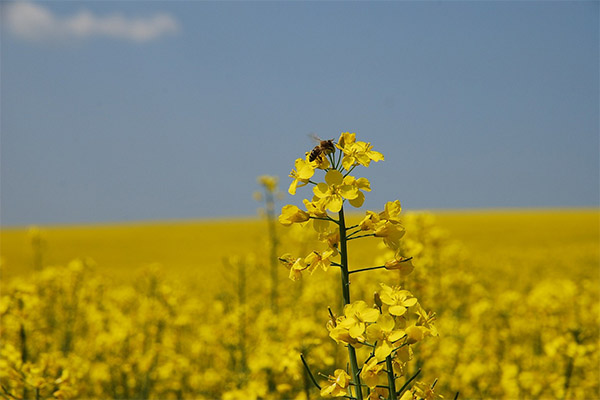
Particularly dangerous is the first spring grass: if you give it without limitation, rabbits, who missed fresh greens during the winter, pile in and get so full that their stomachs swell up, and this can be fatal. Surepka is one of the grasses which appear first in spring, so animals are very fond of it. But you can and should feed them, especially after winter, because this time of the year it's a treasure trove of vitamins. But do not give freshly mowed grass; before giving it out it should be dried.
A little later, closer to the middle of summer, when the plants have already set seeds, driftwood is not suitable for feeding rabbits. Its seeds are poisonous.
Grapes can be made for rabbits over the winter by drying them in the shade and putting them in the hay barn.
contraindications to use
Not everyone is surepka treatment or eating it. First of all, this applies to people with poor blood clotting. It is not recommended to get involved with St. John's wort if you have kidney stone or urolithiasis, because the flavonoids can provoke stone movement and even blockage of the ureters.
During pregnancy and while breastfeeding should not be treated with St. John's wort, because there is a risk of developing allergies.
Those whose body, for various reasons, cannot assimilate various types of cabbage, can expect a negative reaction to grapes as well. It should also be taken into account that as a result of individual intolerance to the components of the rampson can appear allergic rash on the skin.
«Important: All information on this site is provided for informational purposes only purposes only. Consult a specialist before applying any recommendations. specialist. Neither the editors nor the authors shall be liable for any possible harm caused by materials."

